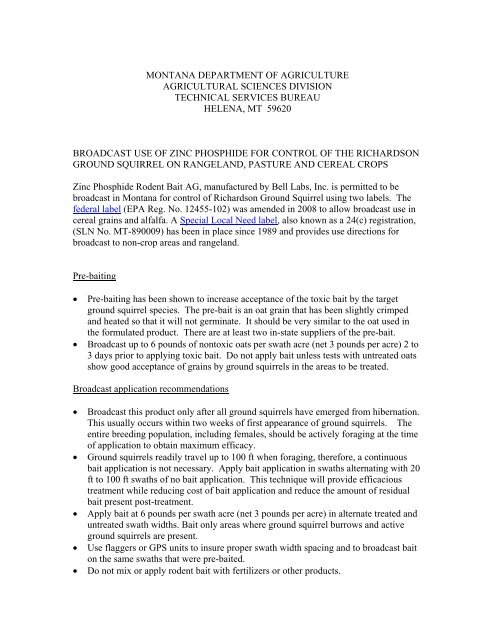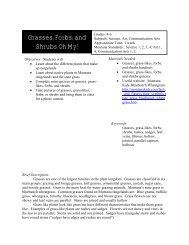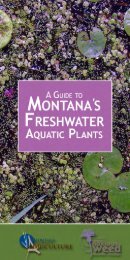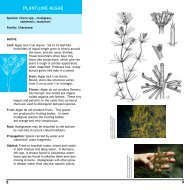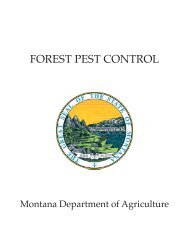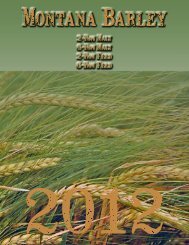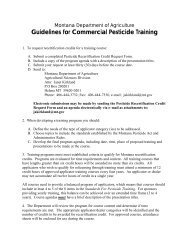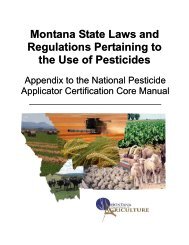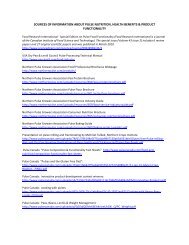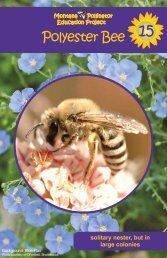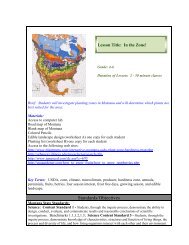Broadcast Use of Zinc Phosphide on Richardson Ground Squirrel
Broadcast Use of Zinc Phosphide on Richardson Ground Squirrel
Broadcast Use of Zinc Phosphide on Richardson Ground Squirrel
Create successful ePaper yourself
Turn your PDF publications into a flip-book with our unique Google optimized e-Paper software.
MONTANA DEPARTMENT OF AGRICULTUREAGRICULTURAL SCIENCES DIVISIONTECHNICAL SERVICES BUREAUHELENA, MT 59620BROADCAST USE OF ZINC PHOSPHIDE FOR CONTROL OF THE RICHARDSONGROUND SQUIRREL ON RANGELAND, PASTURE AND CEREAL CROPS<str<strong>on</strong>g>Zinc</str<strong>on</strong>g> <str<strong>on</strong>g>Phosphide</str<strong>on</strong>g> Rodent Bait AG, manufactured by Bell Labs, Inc. is permitted to bebroadcast in M<strong>on</strong>tana for c<strong>on</strong>trol <str<strong>on</strong>g>of</str<strong>on</strong>g> Richards<strong>on</strong> <strong>Ground</strong> <strong>Squirrel</strong> using two labels. Thefederal label (EPA Reg. No. 12455-102) was amended in 2008 to allow broadcast use incereal grains and alfalfa. A Special Local Need label, also known as a 24(c) registrati<strong>on</strong>,(SLN No. MT-890009) has been in place since 1989 and provides use directi<strong>on</strong>s forbroadcast to n<strong>on</strong>-crop areas and rangeland.Pre-baiting• Pre-baiting has been shown to increase acceptance <str<strong>on</strong>g>of</str<strong>on</strong>g> the toxic bait by the targetground squirrel species. The pre-bait is an oat grain that has been slightly crimpedand heated so that it will not germinate. It should be very similar to the oat used inthe formulated product. There are at least two in-state suppliers <str<strong>on</strong>g>of</str<strong>on</strong>g> the pre-bait.• <str<strong>on</strong>g>Broadcast</str<strong>on</strong>g> up to 6 pounds <str<strong>on</strong>g>of</str<strong>on</strong>g> n<strong>on</strong>toxic oats per swath acre (net 3 pounds per acre) 2 to3 days prior to applying toxic bait. Do not apply bait unless tests with untreated oatsshow good acceptance <str<strong>on</strong>g>of</str<strong>on</strong>g> grains by ground squirrels in the areas to be treated.<str<strong>on</strong>g>Broadcast</str<strong>on</strong>g> applicati<strong>on</strong> recommendati<strong>on</strong>s• <str<strong>on</strong>g>Broadcast</str<strong>on</strong>g> this product <strong>on</strong>ly after all ground squirrels have emerged from hibernati<strong>on</strong>.This usually occurs within two weeks <str<strong>on</strong>g>of</str<strong>on</strong>g> first appearance <str<strong>on</strong>g>of</str<strong>on</strong>g> ground squirrels. Theentire breeding populati<strong>on</strong>, including females, should be actively foraging at the time<str<strong>on</strong>g>of</str<strong>on</strong>g> applicati<strong>on</strong> to obtain maximum efficacy.• <strong>Ground</strong> squirrels readily travel up to 100 ft when foraging, therefore, a c<strong>on</strong>tinuousbait applicati<strong>on</strong> is not necessary. Apply bait applicati<strong>on</strong> in swaths alternating with 20ft to 100 ft swaths <str<strong>on</strong>g>of</str<strong>on</strong>g> no bait applicati<strong>on</strong>. This technique will provide efficacioustreatment while reducing cost <str<strong>on</strong>g>of</str<strong>on</strong>g> bait applicati<strong>on</strong> and reduce the amount <str<strong>on</strong>g>of</str<strong>on</strong>g> residualbait present post-treatment.• Apply bait at 6 pounds per swath acre (net 3 pounds per acre) in alternate treated anduntreated swath widths. Bait <strong>on</strong>ly areas where ground squirrel burrows and activeground squirrels are present.• <str<strong>on</strong>g>Use</str<strong>on</strong>g> flaggers or GPS units to insure proper swath width spacing and to broadcast bait<strong>on</strong> the same swaths that were pre-baited.• Do not mix or apply rodent bait with fertilizers or other products.
• Clean broadcast equipment prior to use for broadcasting rodent bait. Residualchemical dust or odor could adversely affect bait acceptance by rodents.• <str<strong>on</strong>g>Use</str<strong>on</strong>g> a c<strong>on</strong>stant applicati<strong>on</strong> speed when calibrating and broadcasting to prevent over orunder applicati<strong>on</strong>. Recalibrate if a different applicati<strong>on</strong> speed is desired.• Do not apply pre-bait or bait in snowy, or wet weather c<strong>on</strong>diti<strong>on</strong>s or if thesec<strong>on</strong>diti<strong>on</strong>s are expected shortly (24-48 hours) after applicati<strong>on</strong>. Inclement weatherreduces squirrel activity and zinc phosphide bait becomes less acceptable to squirrelsafter exposure to moisture.• Keep human activity to a minimum for several days after pre-bait and bait applicati<strong>on</strong>to insure that rodents have undisturbed feeding access to the bait.• Reduce the rate <str<strong>on</strong>g>of</str<strong>on</strong>g> reinvasi<strong>on</strong> from squirrels occupying areas immediately adjacent tothe treated area by treating a buffer area <str<strong>on</strong>g>of</str<strong>on</strong>g> 50 to 100 yards, if possible.Precauti<strong>on</strong>ary n<strong>on</strong>-target statements• Do not broadcast bait in areas where waterfowl, pheasants, partridge, grouse or otherseed-eating birds c<strong>on</strong>gregate or feed. <str<strong>on</strong>g>Use</str<strong>on</strong>g> other recommended management methodsor appropriate registered rodenticides if rodent c<strong>on</strong>trol is necessary in these areas.• Remove livestock from the area to be baited to reduce trampling <str<strong>on</strong>g>of</str<strong>on</strong>g> the bait andpotential hazards to livestock.• Removal or burying <str<strong>on</strong>g>of</str<strong>on</strong>g> dead carcasses seen above ground is a best managementpractice for this product. Relative to other rodenticides, zinc phosphide has reducedsec<strong>on</strong>dary pois<strong>on</strong>ing effects to n<strong>on</strong>-target species, but may still have an impact.Removal <str<strong>on</strong>g>of</str<strong>on</strong>g> carcasses further reduces the likelihood <str<strong>on</strong>g>of</str<strong>on</strong>g> sec<strong>on</strong>dary effects.For more informati<strong>on</strong>:M<strong>on</strong>tana Special Local Need, 24(c), label for broadcast in rangeland and n<strong>on</strong>-crop areas:http://agr.mt.gov/pestfert/24(c)%20Labels/MT-89-0009%20zp%20rodent%20bait%20ag.pdfBell Labs ZP Rodent Oat Bait Ag label:http://agr.mt.gov/weedpest/pdf/VertBulletins/federalLabel_102-ZP_Oats2-08.pdfCycl<strong>on</strong>e Seeder Calibrati<strong>on</strong> Informati<strong>on</strong> Bulletin:http://agr.mt.gov/weedpest/pdf/vertbulletins/cycl<strong>on</strong>e_calibr_for_zp.pdfTechnical Assistance or Questi<strong>on</strong>s:Amy Bamber, M<strong>on</strong>tana Department <str<strong>on</strong>g>of</str<strong>on</strong>g> Agriculture, Helena 406-444-3676,abamber@mt.govM<strong>on</strong>ty Sullins, M<strong>on</strong>tana Department <str<strong>on</strong>g>of</str<strong>on</strong>g> Agriculture, Billings 406-652-3615,msullins@mt.govRoy Fenster, M<strong>on</strong>tana State University, Bozeman 406-994-5579, rfenster@m<strong>on</strong>tana.edu


